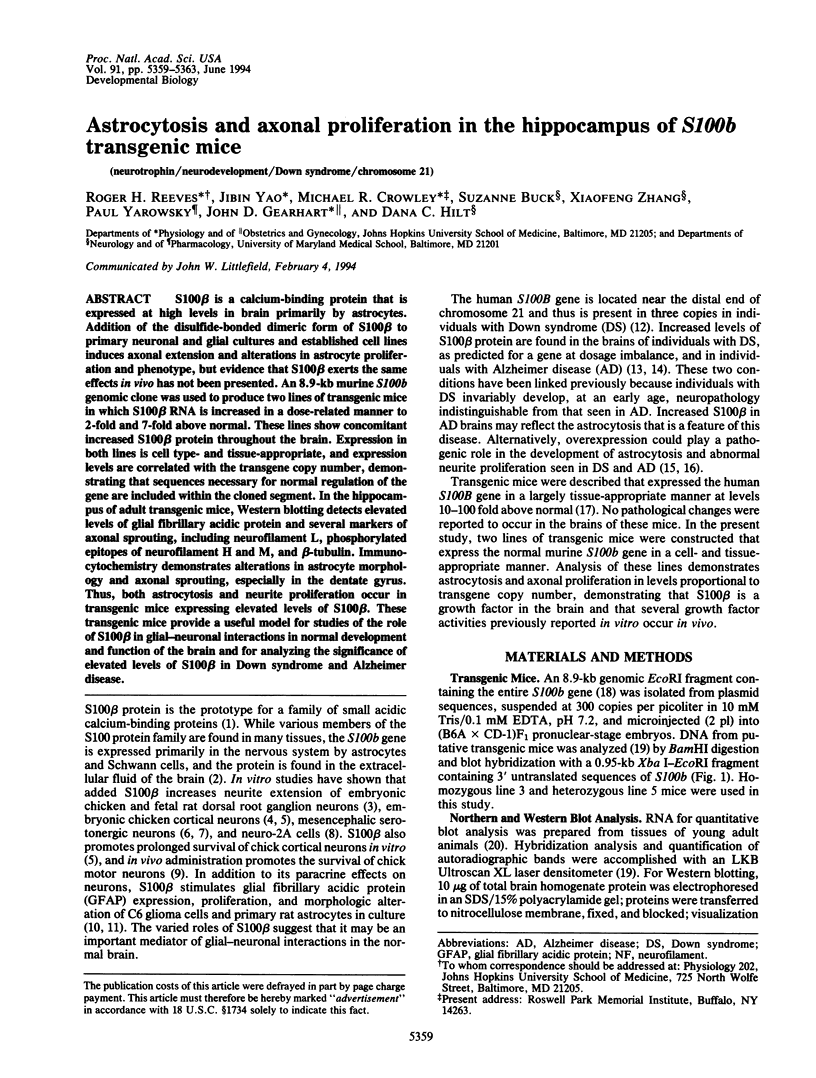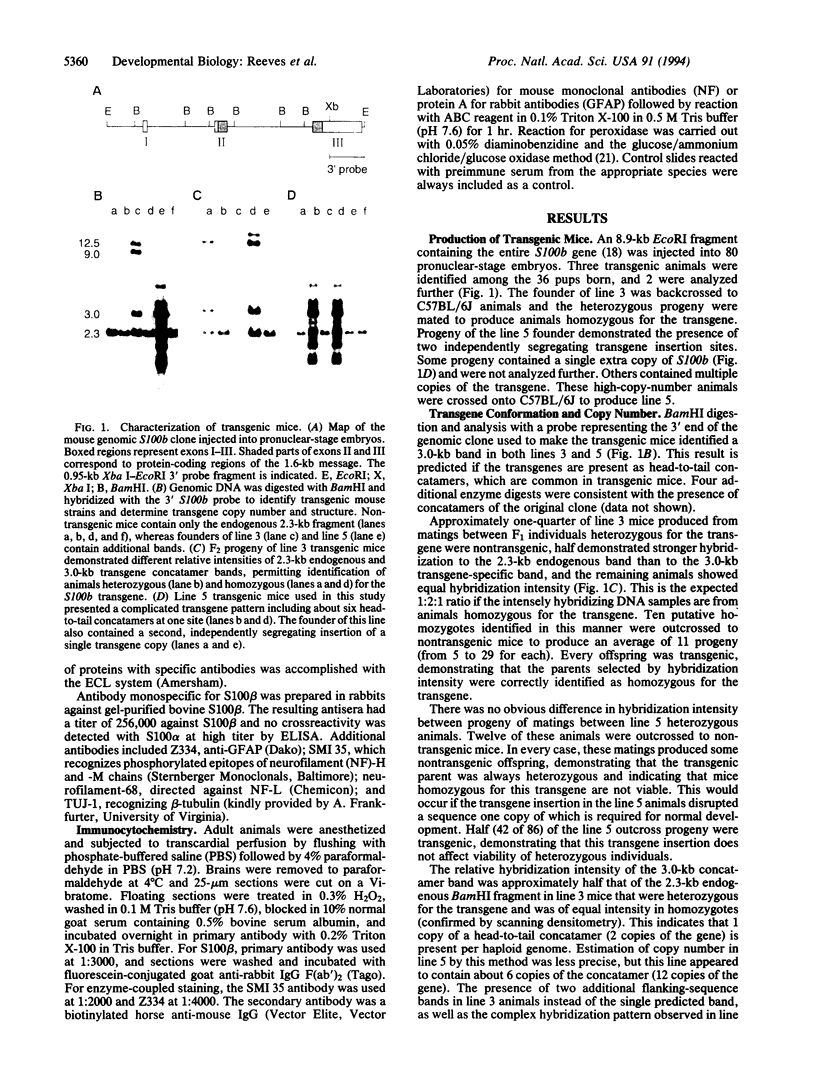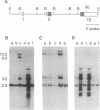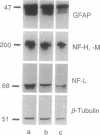Abstract
S100 beta is a calcium-binding protein that is expressed at high levels in brain primarily by astrocytes. Addition of the disulfide-bonded dimeric form of S100 beta to primary neuronal and glial cultures and established cell lines induces axonal extension and alterations in astrocyte proliferation and phenotype, but evidence that S100 beta exerts the same effects in vivo has not been presented. An 8.9-kb murine S100b genomic clone was used to produce two lines of transgenic mice in which S100 beta RNA is increased in a dose-related manner to 2-fold and 7-fold above normal. These lines show concomitant increased S100 beta protein throughout the brain. Expression in both lines is cell type- and tissue-appropriate, and expression levels are correlated with the transgene copy number, demonstrating that sequences necessary for normal regulation of the gene are included within the cloned segment. In the hippocampus of adult transgenic mice, Western blotting detects elevated levels of glial fibrillary acidic protein and several markers of axonal sprouting, including neurofilament L, phosphorylated epitopes of neurofilament H and M, and beta-tubulin. Immunocytochemistry demonstrates alterations in astrocyte morphology and axonal sprouting, especially in the dentate gyrus. Thus, both astrocytosis and neurite proliferation occur in transgenic mice expressing elevated levels of S100 beta. These transgenic mice provide a useful model for studies of the role of S100 beta in glial-neuronal interactions in normal development and function of the brain and for analyzing the significance of elevated levels of S100 beta in Down syndrome and Alzheimer disease.
Full text
PDF




Images in this article
Selected References
These references are in PubMed. This may not be the complete list of references from this article.
- Allore R., O'Hanlon D., Price R., Neilson K., Willard H. F., Cox D. R., Marks A., Dunn R. J. Gene encoding the beta subunit of S100 protein is on chromosome 21: implications for Down syndrome. Science. 1988 Mar 11;239(4845):1311–1313. doi: 10.1126/science.2964086. [DOI] [PubMed] [Google Scholar]
- Azmitia E. C., Dolan K., Whitaker-Azmitia P. M. S-100B but not NGF, EGF, insulin or calmodulin is a CNS serotonergic growth factor. Brain Res. 1990 May 21;516(2):354–356. doi: 10.1016/0006-8993(90)90942-5. [DOI] [PubMed] [Google Scholar]
- Bhattacharyya A., Oppenheim R. W., Prevette D., Moore B. W., Brackenbury R., Ratner N. S100 is present in developing chicken neurons and Schwann cells and promotes motor neuron survival in vivo. J Neurobiol. 1992 Jun;23(4):451–466. doi: 10.1002/neu.480230410. [DOI] [PubMed] [Google Scholar]
- Chomczynski P., Sacchi N. Single-step method of RNA isolation by acid guanidinium thiocyanate-phenol-chloroform extraction. Anal Biochem. 1987 Apr;162(1):156–159. doi: 10.1006/abio.1987.9999. [DOI] [PubMed] [Google Scholar]
- Dunn R., Landry C., O'Hanlon D., Dunn J., Allore R., Brown I., Marks A. Reduction in S100 protein beta subunit mRNA in C6 rat glioma cells following treatment with anti-microtubular drugs. J Biol Chem. 1987 Mar 15;262(8):3562–3566. [PubMed] [Google Scholar]
- Friend W. C., Clapoff S., Landry C., Becker L. E., O'Hanlon D., Allore R. J., Brown I. R., Marks A., Roder J., Dunn R. J. Cell-specific expression of high levels of human S100 beta in transgenic mouse brain is dependent on gene dosage. J Neurosci. 1992 Nov;12(11):4337–4346. doi: 10.1523/JNEUROSCI.12-11-04337.1992. [DOI] [PMC free article] [PubMed] [Google Scholar]
- Geddes J. W., Anderson K. J., Cotman C. W. Senile plaques as aberrant sprout-stimulating structures. Exp Neurol. 1986 Dec;94(3):767–776. doi: 10.1016/0014-4886(86)90254-2. [DOI] [PubMed] [Google Scholar]
- Griffin W. S., Stanley L. C., Ling C., White L., MacLeod V., Perrot L. J., White C. L., 3rd, Araoz C. Brain interleukin 1 and S-100 immunoreactivity are elevated in Down syndrome and Alzheimer disease. Proc Natl Acad Sci U S A. 1989 Oct;86(19):7611–7615. doi: 10.1073/pnas.86.19.7611. [DOI] [PMC free article] [PubMed] [Google Scholar]
- Jiang H., Shah S., Hilt D. C. Organization, sequence, and expression of the murine S100 beta gene. Transcriptional regulation by cell type-specific cis-acting regulatory elements. J Biol Chem. 1993 Sep 25;268(27):20502–20511. [PubMed] [Google Scholar]
- Jørgensen O. S., Brooksbank B. W., Balázs R. Neuronal plasticity and astrocytic reaction in Down syndrome and Alzheimer disease. J Neurol Sci. 1990 Aug;98(1):63–79. doi: 10.1016/0022-510x(90)90182-m. [DOI] [PubMed] [Google Scholar]
- Kato K., Kurobe N., Suzuki F., Morishita R., Asano T., Sato T., Inagaki T. Concentrations of several proteins characteristic of nervous tissue in cerebral cortex of patients with Alzheimer's disease. J Mol Neurosci. 1991;3(2):95–99. doi: 10.1007/BF02885530. [DOI] [PubMed] [Google Scholar]
- Kligman D., Hilt D. C. The S100 protein family. Trends Biochem Sci. 1988 Nov;13(11):437–443. doi: 10.1016/0968-0004(88)90218-6. [DOI] [PubMed] [Google Scholar]
- Kligman D., Hsieh L. S. Neurite extension factor induces rapid morphological differentiation of mouse neuroblastoma cells in defined medium. Brain Res. 1987 Jun;430(2):296–300. doi: 10.1016/0165-3806(87)90163-5. [DOI] [PubMed] [Google Scholar]
- Kligman D. Isolation of a protein from bovine brain which promotes neurite extension from chick embryo cerebral cortex neurons in defined medium. Brain Res. 1982 Oct 28;250(1):93–100. doi: 10.1016/0006-8993(82)90955-6. [DOI] [PubMed] [Google Scholar]
- Kligman D., Marshak D. R. Purification and characterization of a neurite extension factor from bovine brain. Proc Natl Acad Sci U S A. 1985 Oct;82(20):7136–7139. doi: 10.1073/pnas.82.20.7136. [DOI] [PMC free article] [PubMed] [Google Scholar]
- Liu J. P., Lauder J. M. S-100 beta and insulin-like growth factor-II differentially regulate growth of developing serotonin and dopamine neurons in vitro. J Neurosci Res. 1992 Oct;33(2):248–256. doi: 10.1002/jnr.490330208. [DOI] [PubMed] [Google Scholar]
- O'Hara B. F., Fisher S., Oster-Granite M. L., Gearhart J. D., Reeves R. H. Developmental expression of the amyloid precursor protein, growth-associated protein 43, and somatostatin in normal and trisomy 16 mice. Brain Res Dev Brain Res. 1989 Oct 1;49(2):300–304. doi: 10.1016/0165-3806(89)90031-x. [DOI] [PubMed] [Google Scholar]
- Selinfreund R. H., Barger S. W., Pledger W. J., Van Eldik L. J. Neurotrophic protein S100 beta stimulates glial cell proliferation. Proc Natl Acad Sci U S A. 1991 May 1;88(9):3554–3558. doi: 10.1073/pnas.88.9.3554. [DOI] [PMC free article] [PubMed] [Google Scholar]
- Shashoua V. E., Hesse G. W., Moore B. W. Proteins of the brain extracellular fluid: evidence for release of S-100 protein. J Neurochem. 1984 Jun;42(6):1536–1541. doi: 10.1111/j.1471-4159.1984.tb12739.x. [DOI] [PubMed] [Google Scholar]
- Sloviter R. S. Calcium-binding protein (calbindin-D28k) and parvalbumin immunocytochemistry: localization in the rat hippocampus with specific reference to the selective vulnerability of hippocampal neurons to seizure activity. J Comp Neurol. 1989 Feb 8;280(2):183–196. doi: 10.1002/cne.902800203. [DOI] [PubMed] [Google Scholar]
- Van Eldik L. J., Christie-Pope B., Bolin L. M., Shooter E. M., Whetsell W. O., Jr Neurotrophic activity of S-100 beta in cultures of dorsal root ganglia from embryonic chick and fetal rat. Brain Res. 1991 Mar 1;542(2):280–285. doi: 10.1016/0006-8993(91)91579-p. [DOI] [PubMed] [Google Scholar]
- Winningham-Major F., Staecker J. L., Barger S. W., Coats S., Van Eldik L. J. Neurite extension and neuronal survival activities of recombinant S100 beta proteins that differ in the content and position of cysteine residues. J Cell Biol. 1989 Dec;109(6 Pt 1):3063–3071. doi: 10.1083/jcb.109.6.3063. [DOI] [PMC free article] [PubMed] [Google Scholar]






